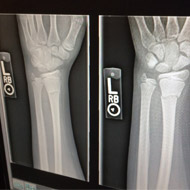
Technique has many potential applications
Improved therapies for spinal injuries, bone grafts and other orthopaedic surgeries could be on the horizon thanks to a technique developed by scientists at the University of Glasgow.
A study published in the journal Science Advances describes how biomedical engineers used an inexpensive, commercially-produced polymer to help stimulate ‘growth factors’ - molecules which help the body to regenerate.
“The ease in which the polymer can be used to do something very biologically complex is extraordinary and mimics the way growth factors are used naturally in the body,” said Matthew Dalby, professor of cell engineering at the University of Glasgow.
Growth factors play an important role in developmental biology and govern development as bodies grow and age. For several years, scientists have used a molecule called morphogenetic protein 2, or BMP-2, in clinical applications to stimulate the regrowth of bone.
However, wider adoption of BMP-2 techniques has been hindered by the human body’s tendency to pass the protein quickly through its system.
To overcome this, clinicians had to administer the molecule in large doses, which can cause harmful side effects like neurological impairment or tumours.
Researchers say the new technique uses a property of polymer poly(ethyl acrylate) to allow growth factors to be effective at doses around 300 times lower than currently possible. Lower doses lower the risk of harmful side-effects and reduce the potential cost of treatment.
“This technique opens up the possibility of making growth factor treatments much more effective and much more affordable,” said Professor Manuel Salmeron-Sanchez, the university’s chair of biomedical engineering.
“By coating materials such as hip implants, bone grafts or spinal cages in a thin layer of this polymer, we can encourage bone regeneration targeted on the areas where they’re required.”
The team say there are many potential applications for the process, like helping people who have suffered injuries in car accidents or lost significant areas of bone during cancer treatments.
“We’re in the process of securing additional funding to further explore our findings, and we hope that the first human trial could be underway in the next five years,” Professor Salmeron-Sanchez adds.
The study, 'Material-drive fibronectin assembly for high-efficiency presentation of growth factors', is published in Science Advances.
Image (C) Pixabay



 The RCVS has announced a new version of its 1CPD mobile app, with enhanced features for veterinary surgeons and veterinary nurses to record their continuing professional development.
The RCVS has announced a new version of its 1CPD mobile app, with enhanced features for veterinary surgeons and veterinary nurses to record their continuing professional development.